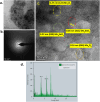Novel dual-functional manganese stannate thin film for acetone gas sensing and photocatalytic methyl orange degradation
- PMID: 40191140
- PMCID: PMC11969144
- DOI: 10.1039/d4ra08391a
Novel dual-functional manganese stannate thin film for acetone gas sensing and photocatalytic methyl orange degradation
Abstract
Increasing health concerns due to pollution has led to the development of various materials to control exposure to pollutants such as toxic gases and contaminated water. In this study, novel manganese stannate (MTO) composite thin films were synthesized via sol-gel spin coating and their structural, morphological, and chemical properties were extensively characterized. In addition, their photocatalytic and gas-sensing abilities were evaluated. In photocatalysis, degradation efficiency measures of how well a photocatalyst can degrade pollutants or dyes under light exposure. Remarkably, the MTO film exhibited a high degradation efficiency of 67% for methyl orange (MO) dye when exposed to UV light for 150 minutes. We also examined the gas-sensing properties of the MTO thin films, particularly their response to acetone. In gas sensors, sensitivity is often reported as a percentage, indicating the relative change in the sensor's response per unit change in analyte concentration. Herein, the sensors displayed a linear response within the 1-9 ppm range of acetone concentration at an operating temperature of 200 °C. They also exhibited excellent selectivity, sensitivity, and repeatability, thus emerging as promising candidates for acetone gas-sensing applications. A sensitivity of 22% was achieved by the sensors, allowing for a low detection limit of 1 ppm, which indicated their high sensitivity towards acetone gas. Moreover, the MTO sensor exhibited response and recovery times of 15 and 16 seconds, respectively. Based on these results, the MTO thin film is a potential material for photocatalytic MO degradation and a gas sensor for acetone detection.
This journal is © The Royal Society of Chemistry.
Conflict of interest statement
There are no conflicts to declare.
Figures






References
-
- Li Z. Yang H. Zhang L. Liu R. Zhou Y. Stainless steel mesh-supported three-dimensional hierarchical SnO2/Zn2SnO4 composite for the applications in solar cell, gas sensor, and photocatalysis. Appl. Surf. Sci. 2020;502:144113. doi: 10.1016/j.apsusc.2019.144113. - DOI
-
- Perla V. K. Ghosh S. K. Mallick K. Role of Carbon Nitride on the Resistive Switching Behavior of a Silver Stannate Based Device: An Approach to Design a Logic Gate Using the CMOS-Memristor Hybrid System. ACS Appl. Electron. Mater. 2023;5:1620–1627. doi: 10.1021/acsaelm.2c01686. - DOI
-
- Sahoo S. Sood A. Kumar R. Milton A. Choi S. M. Jo Y. J. Hussain I. Han S. S. Rapid in-situ fabrication of MnSnO3 perovskite-based nanocomposites via microwave-assisted approach for supercapacitor devices. J. Energy Storage. 2025;110:115368–115378. doi: 10.1016/j.est.2025.115368. - DOI
-
- Hwa K. Y. Santhan A. Ganguly A. Sharma T. S. K. Point of need simultaneous biosensing of pharmaceutical micropollutants with binder free conjugation of manganese stannate micro-rods on reduced graphene oxide in real-time analysis. J. Taiwan Inst. Chem. Eng. 2022;131:104135–104150. doi: 10.1016/j.jtice.2021.11.002. - DOI
-
- Barai H. R. Rahman M. M. Adeel M. Joo S. W. MnSn(OH)6 derived Mn2SnO4@Mn2O3 composites as electrode materials for high-performance Supercapacitors. Mater. Res. Bull. 2022;148:111678. doi: 10.1016/j.materresbull.2021.111678. - DOI
LinkOut - more resources
Full Text Sources

